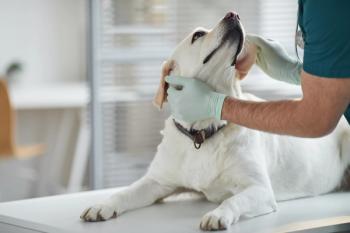
Hyperthyroidism: Cats can Live a Normal Life
Q: I have been managing several older cats with hyperthyroidism. Please provide some practical updated information about feline hyperthyroidism.
Q: I have been managing several older cats with hyperthyroidism. Please provide some practical updated information about feline hyperthyroidism.
Table 1
A: Hyperthyroidism occurs most often in middle-aged to geriatric-aged cats. Most feline cases of hyperthyroidism are the result of hyperplastic or benign adenomatous thyroid glands; thyroid carcinomas are uncommon and found in only 1-2 percent of all cases. Traditionally, the most common signs associated with hyperthyroidism are weight loss in spite of polyphagia, nervousness or hyperactivity, polydipsia and polyuria, diarrhea, intermittent fever, dyspnea, vomiting, signs of cardiovascular disease and tachycardia and hair loss. Voice change and congestive heart failure may occur but are uncommon. Weight loss is a common owner complaint but is usually accompanied by lethargy and anorexia rather than hyperactivity and polyphagia. Today, the goal of veterinarians is to diagnose hyperthyroidism early, well before these obvious signs of disease occur.
In hyperthyroid cats, enlargement of one or both thyroid lobes may be palpated; sometimes one or both thyroid lobes may be visibly enlarged. However, some hyperthyroid cats may not have palpably enlarged thyroid lobes. Furthermore, some cats with enlarged thyroid lobes are not yet hyperthyroxinemic.
Hyperthyroidism is increasingly being recognized as a cause of hypertension and retinopathy in the cat. The combination of hyperthyroidism and chronic renal disease is very likely to cause hypertension that requires some form of medical management.
Diagnostics
Annual screening laboratory tests (CBC, serum chemistry profile and serum T4 measurement), comprehensive retinal examinations and systolic/diastolic blood pressure determination should always be performed in a cat 7 years of age and older and in a cat suspected of having hyperthyroidism. Results from blood tests may show mild increases in the hematocrit and serum liver enzymes. Hyperthyroid cats have increased bone turnover and increases in serum alkaline phosphatase activity and phosphorus concentration may result.
Hyperthyroid cats may also show cardiac abnormalities associated with a secondary cardiomyopathy and, therefore, thoracic radiographs, electrocardiogram and ultrasound study should be performed on those cats with murmurs. It does appear, however, that the cardiorespiratory signs have decreased in incidence since hyperthyroidism was first recognized.
Older cats often have borderline renal function indicated by an increase in BUN and serum creatinine concentrations. It is now apparent that cats with hyperthyroidism and "high-normal" creatinine concentrations may progress to mild-moderate azotemia following a return to euthyroidism. In addition, renal disease will continue to develop regardless of the treatment modality used for the hyperthyroidism.
Several specific diagnostic tests are available to confirm hyperthyroidism. In most cases, circulating thyroid hormone thyroxine (T4) concentration is increased. In mild cases or cases of overlying non-thyroidal illness, which will depress serum T4 values, repeat measurements of serum T4 several days after the first determination can eventually diagnose hyperthyroidism. Alternatively, some veterinary internists to look for the unusual case or for the purpose of peer-to-peer discussion advocate other serum tests. I have found generally that using the simple serum T4 measurement(s) to be more than adequate.
The most appropriate treatment modality used in the management of a hyperthyroid cat are determined by the general health condition of the cat, owner's desire to cure the cat, veterinarian's skills in thyroid surgery, availability of radioiodine treatment facilities and cost of the treatment modalities.
Without any serious irreversible medical problems, a hyperthyroid cat despite its age can, with appropriate therapy, live out a normal life. Concomitant primary/secondary cardiomyopathy, chronic renal disease and hypertension will make the hyperthyroid cat have a poorer prognosis.
Treatment
Several studies during the past seven years have shown that resolution of hyperthyroidism by any modality (surgery, methimazole or radioiodine) will lead to a decrease in glomerular filtration rate after treatment. Approximately 15-20 percent of treated hyperthyroid cats will show an increase in BUN and serum creatinine concentration to above the normal range four to six weeks after treatment - only about 7 percent of cats will decompensate to a serum creatinine of greater than 4.0 mg/dl. If more severe azotemia (serum creatinine concentration greater than 3.5 mg/dl) develops during methimazole treatment and especially with progressive signs of renal failure, then methimazole should be discontinued and fluid therapy provided.
In these cats, lower doses of methimazole may then be attempted, with the goal being to keep serum T4 concentration in the high end of the normal range and serum creatinine concentration less than 3.5 mg/dl (or whatever level at which the cat feels well and eats). Any uncontrolled hypertension can then be treated with amlodipine (3.125 to 6.25 mg per cat orally BID).
Pre-surgical medical management should include that the cat ideally be euthyroid at the time of surgery to reduce the anesthetic risk. All abnormal thyroid tissue should be removed while maintaining at least the external parathyroid glands.
Cats that have more severe hyperthyroidism generally have high serum T4 concentrations and large thyroid lobe tumors. The preferred drug treatment for hyperthyroidism in the United States is methimazole (Tapazole). Methimazole acts by blocking thyroid hormone synthesis at the level of the thyroid gland. The overall treatment plan prescribed is that methimazole should be given multiple times daily for the rest of the animal's life if surgery or radioiodine therapy is not done. Side effects of methimazole usually occur within the first month of therapy and include GI upset (10 to 20 percent of cats experience anorexia and vomiting) facial excoriation, severe thrombocytopenia, severe leukopenia, worsening elevations in serum liver enzymes or hyperbilirubinemia. It is always important to rule out renal decompensation as a cause of anorexia and vomiting in any methimazole-treated cat. Reactions usually subside within two weeks after stopping medication. There is a strong correlation between the dose of methimazole needed to control hyperthyroidism and the initial serum T4 concentration.
Practice tip: Twice daily, divided dosing of methimazole is more effective than the same total daily dose given once daily in treating cats with newly diagnosed hyperthyroidism. (Hoffman SB, et al: Evaluation of dosing regimen in hyperthyroid cats treated with methimazole. J Vet Intern Med 15:299, 2001.)
Another medication used in the management of hyperthyroidism is atenolol (6.25 mg/cat SID or BID), a selective beta-one blocker that can be used with methimazole to help slow the heart rate. Atenolol alone may be insufficient to control accompanying hypertension. If hypertension is not controlled after one week on atenolol, amlodipine (3.125 to 6.25 mg per cat orally BID) should be added.
A look at radioiodine
The most specific and medically safe treatment for hyperthyroidism is radioiodine. The thyroid glands concentrate iodine and radioactive iodine will destroy the functioning thyroid cells without destroying other tissue, such as the parathyroid glands. Radioiodine treatment is 90 percent effective resulting in normalization of serum T4 concentration in one to two weeks. It is generally recommended that methimazole therapy be withdrawn for at least five to seven days in hyperthyroid cats prior to radioiodine therapy.
Owners often ask how long they can expect their cat to live if radioiodine therapy is performed. See Table 1, page 5S.
A limited number of hyperthyroid cats with unilateral thyroid disease have been successfully treated with a percutaneous injection of ethanol into the enlarged thyroid lobe. These cats are imaged with both ultrasound and nuclear scintigraphy with technetium pertechnetate prior to ethanol treatment. Injection is performed under propofol sedation with ultrasound guidance. Cats are expected to be euthyroid within two days and remain euthyroid after treatment. However, additional work in a larger number of hyperthyroid cats is needed to determine whether this method is safe and effective long term.
Hyperthyroidism occurs most often in middle-aged to geriatric-aged cats. Without any serious irreversible medical problems, a hyperthyroid cat despite its age can, with appropriate therapy, live out a normal life. Concomitant primary/secondary cardiomyopathy, chronic renal disease and hypertension will make the hyperthyroid cat have a poorer prognosis. Several studies during the past seven years have shown that resolution of hyperthyroidism by any modality (surgery, methimazole or radioiodine) will lead to a decrease in glomerular filtration rate after treatment.
Newsletter
From exam room tips to practice management insights, get trusted veterinary news delivered straight to your inbox—subscribe to dvm360.






